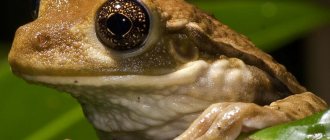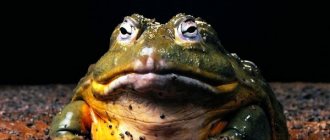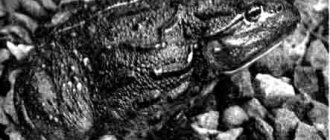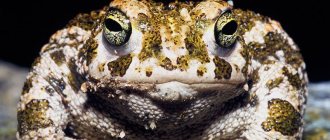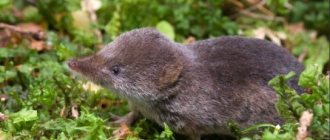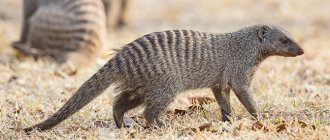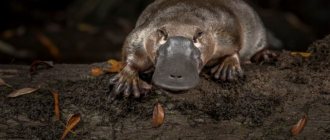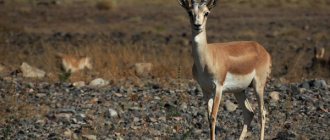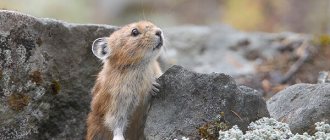- Wild animals
- >>
- Amphibians
The lake frog is the most typical representative of the family of true frogs. To meet him, residents of some cities simply need to leave the city to some body of water. This amphibian is easily distinguished by its characteristic stripe along the head and spine. The lake frog is the most widespread species of the group. They most often live where the water temperature reaches at least 15 degrees Celsius. Let's talk more about this type of frog.
In this article:
|
Origin of the species and description
Photo: Lake frog
The first mention of the lake frog appeared in 1771. The Latin name Pelophylax ridibundus was given to this species at that time by the German encyclopedist Pallas Peter Simon. This man discovered many new species of various classes of animals. Some fauna were even named after him.
The lake frog is the largest species of amphibian in Russia. Most often they can be found in reservoirs of anthropogenic origin. According to official data, this species of frog appeared on the territory of our country in 1910 and was mistakenly described as a giant frog - Rana florinskii.
Recommended reading and useful links
- Maslova I.V. The influence of climate on certain aspects of the life activity of amphibians and reptiles (Russian): collection / Comp. A. O. Kokorin. - Moscow: WWF Russia, 2006. - P. 111. - ISBN 5895640370. - Bibcode: 26.23В58.
- Ananyeva N. B., Borkin L. Ya., Darevsky I. S., Orlov N. L. Five-language dictionary of animal names. Amphibians and reptiles. Latin, Russian, English, German, French. / under the general editorship of academician.
- Ferrell, Vance. Geographical Distribution. Evolution Encyclopedia, Volume 3. Evolution Facts (March 4, 2012). Dahl, Chris; Novotny, Vojtech; Moravec, Jiri; Richards, Stephen J. Beta diversity of frogs in the forests of New Guinea, Amazonia and Europe: contrasting tropical and temperate communities // Journal of Biogeography (English) Russian. : journal. - 2009. - Vol. 36, no. 5. - P. 896?904. — DOI:10.1111/j.1365-2699.2008.02042.x.
- Shabanov D. A., Litvinchuk S. N. Green frogs: life without rules or a special way of evolution? (Russian) // Nature: magazine. - Science, 2010. - No. 3. - P. 29-36.
- Kartashev N.N., Sokolov V.E., Shilov I.A. Workshop on vertebrate zoology.
Appearance and features
Photo: Lake frog
The lake frog has an elongated skeleton, an oval skull and a pointed muzzle. The appearance of the lake frog is not very different from other representatives of this family. If you look closely, you will notice that the lower part of the body, colored gray or slightly yellowish, also has numerous dark spots. From above, the frog's body has a color similar to its abdomen. The eyes of individuals are mostly golden in color.
Among the features of this species, one can note its impressive mass, which sometimes reaches 700 g. Compared with other frogs, this number makes it clear that the lake frog is not one of the lightest representatives in its family.
Lifestyle
Frogs love to jump on grass wet with dew. During this time, they replenish their water supply and breathe through their skin. But in cold and dry weather, they huddle in shelters, which can be small fir trees, rotten stumps, snags, and piles of brushwood. If there is no suitable shelter nearby, frogs bury themselves in leaf litter.
Despite its excellent jumping ability, the grass frog is far from a fast walker. In a whole week, she sometimes travels only thirty meters long. And only in the most hunting, wet weeks, the range increases to half a kilometer. It's not easy to run away from the enemy at that speed. Therefore, the frog prefers not to catch his eye. It achieves this goal thanks to its ability to change color, adapting to the color of the surrounding soil.
The spectrum of the grass frog is much richer than that of the pond frog. This is explained by the fact that the first one spends most of its life on land, where the palette is very diverse. The pond frog usually lives in water and hides among thickets of green plants. Therefore, her palette is more modest: from dark green to yellowish-green. The change in color depends on the regulation of body temperature in accordance with the well-known physical law: dark objects absorb heat, and light ones reflect it. However, color is affected not only by temperature, but also by background color, light, and humidity. Frogs perceive changes in these factors directly through the skin, as evidenced by experiments on blind animals.
Frog skin has special colored cells - black, orange, white. They can expand and contract. Color change is also carried out due to the movement of special colored particles. Such a variety of sensitive elements makes it possible to perceive such optical properties of light as decomposition, refraction, reflection, and scattering. This entire complex mechanism responsible for skin coloring is regulated by the nervous system and the endocrine glands - the pituitary gland and the pineal gland.
One of the most original adaptations to living conditions in the border zone between land and water is the frog's hearing aid. It turns out that she perceives sound signals through three channels. In the air, sound waves are captured by the sensitive cells of the inner ear, through the eardrum and ear bone. Sounds traveling through the soil are perceived by the bones and muscles of the limbs and are transmitted through the bones of the skull to the inner ear. And finally, sounds in water, as zoologists suggest, are captured by the skin and enter the inner ear through the circulatory system. In the latter case, sound travels through a homogeneous medium: water - blood - fluid of the inner ear.
This is how simply and wittily these animals coped with difficult living conditions, how they were able to turn to their advantage even the difficulties caused by the need to adapt to life on the border of two environments.
Where does the lake frog live?
Photo: Lake frog
The lake frog has become widespread in different parts of the world. At the moment, in addition to Russia, it can be found in some parts of Europe, Asia, and also in North Africa.
Among the most densely populated places in Europe are usually:
- Crimea;
- Kazakhstan;
- Caucasus.
In Asia, lake frogs became more widespread near Kamchatka. This is due to the fact that geothermal springs can often be found on the peninsula. The temperature in them reaches about 20 degrees Celsius, and this, as is known, is a very favorable factor for the life of this species.
On the territory of our country, the lake frog can be found with a particularly high probability if you live in Tomsk or Novosibirsk. In rivers such as the Tom and Ob, they are one of the main inhabitants.
Video
And finally, an interesting documentary about monster frogs.
Author: Pavel Chaika, editor-in-chief of Poznavaika magazine
When writing the article, I tried to make it as interesting, useful and high-quality as possible. I would be grateful for any feedback and constructive criticism in the form of comments on the article. You can also write your wish/question/suggestion to my email [email protected] or Facebook, with respect, the author.
Author page
What does the lake frog eat?
Photo: Lake frog
The diet of this species is no different from the family as a whole. Lake frogs prefer larvae of dragonflies, water beetles, and mollusks as their food. If the above food is in short supply or absent, they can eat a tadpole of their own species or a fry of some river fish.
In the next paragraph we will mention the dimensions of the amphibian in question, which are one of the main distinguishing features from other species of the family. Thanks to them, the lake frog can sometimes attack small mammals such as a vole or shrew, small birds, chicks and young snakes.
Nutrition
Insectivorous frogs are predators, happily eating mosquitoes, butterflies and small invertebrates. Particularly large ones do not disdain more impressive prey; some species of animal frogs even mercilessly devour their own relatives.
To hunt their victims, frogs use a sticky and long tongue, which they use to deftly catch midges, dragonflies and other living creatures in mid-flight. Among the frog species there are also omnivores that happily eat fruit.
Frogs bring quite a lot of benefits to humans, destroying and eating many harmful worms, beetles and insects. Therefore, many owners of vegetable gardens and household plots treat such helpers with great sympathy and create all the conditions for them to breed and live.
Frogs are eaten, making them extremely original dishes, which are delicacies and are used for gourmet tables.
Features of character and lifestyle
Photo: Lake frog
The lake frog of the family of true frogs is the largest species of amphibian in Eurasia. In nature, you can find individuals whose dimensions reach a length of more than 17 centimeters. It is interesting to note that in this species, females are often much larger than males.
Like all frogs, the lake frog lives mainly on the banks of reservoirs. Thanks to its coloring, it can easily remain undetected in any weather conditions. Its characteristic dorsal stripe, which is often bright green, helps to camouflage itself on the stems of aquatic plants.
To live, lake frogs prefer reservoirs with a minimum depth of 20 centimeters. Most often this species can be found in endorheic reservoirs - lakes, ponds, ditches, and so on.
The lake frog is active around the clock, so if it notices danger, it immediately reacts and hides in the water. It lives on the banks in the afternoon, as it hunts at this time. During winter, the lake frog can remain active if the water temperature does not change much.
Diet
What does the lake frog eat? It all depends on age, habitat, gender and time of year. They feed both on land and in water.
Land hunting takes place just a few meters from the shore. This amphibian is a real predator. Due to its impressive size, its potential prey can be a small lizard and snake, a mouse, a chick and even a smaller frog.
In the water, newts, small fish and their own tadpoles become lunch. The main diet includes invertebrates - crustaceans, insects, mollusks, centipedes and worms.
The lake frog can catch its prey even in flight. Usually these are butterflies, flies, dragonflies. During the hunt, she actively uses her tongue, throwing it several centimeters forward. Sticky mucus helps to hold mobile prey. If the prey is at a great distance, then the amphibian creeps up to it carefully. The frog can also jump very precisely, landing in the right place.
The main diet of tadpoles is small algae.
Social structure and reproduction
Photo: Lake frog
It is interesting to note that the reproduction of the lake frog, unlike other amphibians, is not accompanied by migration. Being thermophilic, males show their first readiness to mate when the water temperature reaches from +13 to +18 degrees. Singing begins, which is caused by the widening of the corners of the mouth. Additional sound amplification is given to them by special hollow balls - resonators, which inflate when croaking.
Frogs gather in groups, and males are not very picky, so they can capture one female in a group or even confuse her with something inanimate.
Spawning will only occur in sufficiently warm and protected conditions. One frog can lay up to 12 thousand eggs. The entire breeding season lasts a month.
Numerous tadpoles spread throughout the reservoir, feeding on algae and waiting for their turn to reach puberty, which occurs a year or more after their metamorphosis.
Description of the animal
According to taxonomy or biological systematics, the lake frog (Pelophylax ridibundus) belongs to the class Amphibians, order Tailless amphibians, family True frogs. Characteristics of the species are the absence of a tail, a narrow tongue reaching a third of the body length, prominent eyes, and tucked limbs.
The animals are not considered poisonous because the parotid glands, which produce toxins, are undeveloped. Starting from the end of April, loud croaking of males with a wide sound range can be heard in wetlands, ponds, and lakes. The voice is amplified by resonators located in the corners of the mouth.
Sexual deformity is manifested in size (females are larger), the formation of gray calluses in males on the first toe of the front paws. Life expectancy in the natural environment is 10–11 years.
Translated into Russian, the Latin name of the species means laughing.
What does it look like
When the lake frog is stationary, the camouflage pattern blends in with its surroundings. The color of the back and upper part of the head, depending on the inhabited territory, varies from green to brown.
The monotony is diluted by dark spots of a vague configuration. Often, but not always, a dividing light stripe runs along the spine, resembling the leaf of an aquatic plant. The dirty white belly with yellowish tint is strewn with small spots. With a body length of up to 17 cm, the weight of an adult reaches 0.7 kg.
The amphibian is larger in those areas where the habitat is more favorable for development and life. The lake frog looks like a typical representative of the family. The oval, flattened skull with a pointed muzzle continues the elongated massive body without a tail, but with long hind legs.
Golden eyes with horizontal pupils are pushed forward to improve vision. Scientists have proven that vertebrates only see moving objects. If you place a delicious, immobilized insect next to it on the ground, the animal will not notice the treat.
Behind the eyes are the eardrums. But the amphibian will not react even to a loud sound until it visually assesses the source of danger.
Varieties
The species of lake amphibians include pond frogs and edible frogs. The pond amphibian is much smaller in size (8 cm), its belly is one color without spots. Dark stripes run from the tip of the muzzle through the nostrils and eyes.
Other features;
- white resonator;
- developed membranes;
- high calcaneal tubercle;
- nuptial calluses in males on two or three fingers.
The edible variety was formed by the mating of lake and pond amphibians. Its meat immediately became a delicacy among the French, hence the name. The hybrid animal grows up to 10 cm. Color - brown, olive, light green.
Distinctive features are weakly expressed, as they are intermediate between the parents. Semiclonal reproduction involves living among one of the parent species.
Character and lifestyle
The lake frog is active around the clock during the warm season. The main methods of movement are jumping and swimming. It forages on the shore from noon to evening. The amphibian moves no further than 50 m from the reservoir. An isolated case was recorded when the animal was found in the forest at a distance of half a kilometer from the water source.
Sexually mature individuals communicate with each other using croaking to find a mate. You can often hear a polyphonic chorus of males and females responding to the call, choosing the partner with the loudest, deepest voice. It is believed that males with such vocal abilities are strong and hardy, and are more likely to produce healthy offspring.
On the shore, frogs not only hunt, but also sit motionless, basking in the sun's rays. When enemies approach, they dive into the water and hide, huddling under a snag. They return to shore after they are convinced that the danger has passed.
For residence, amphibians choose urban and suburban reservoirs - puddles deeper than 20 cm, oxbow rivers, lakes, ponds, springs. They readily inhabit artificial canals, reservoirs, and dams. During drought they are able to migrate up to 12 km.
What does it eat?
Up to 90% of the diet of tailless amphibians consists of insects and fish fry. The animal can also attack animals, chicks, and voles. The lake frog happily eats:
- aphids;
- butterflies;
- dragonflies;
- flies;
- Zhukov;
- larvae;
- caterpillars, earthworms (rare);
- spiders;
- newts;
- shellfish
Small aquatic invertebrates and algae are eaten by tadpoles. Cannibalism is common among tailless amphibians. Adult individuals with a large population feast on tadpoles and frogs of other smaller species.
When obtaining food, amphibians lick with their sticky tongue hymenoptera perched on a leaf. If an insect has landed on the ground in the distance, they silently sneak up before throwing. Lake frogs are able to catch a flying dragonfly or a fly in a jump.
Where does it live?
The species range is extensive. In Russia, these are the central regions, Novosibirsk, Tomsk regions, fresh water bodies of Kamchatka near geothermal springs. Isolated populations were formed as a result of random settlement and economic activity.
For example, frogs were brought to Gorno-Altaisk as laboratory animals. Gradually, the amphibians rafted down the rivers and reached Novosibirsk.
Amphibians inhabited deciduous and mixed forests of European countries and desert zones in northern Africa. Amphibians are found in China, Iran, Turkey, and the entire post-Soviet space, except Tajikistan. Frogs survive even in the Caucasus at an altitude of up to 2.5 thousand km above sea level.
Reproduction
When the water warms up to a temperature of 12 °C and above, mating occurs among lake frogs that have reached sexual maturity (from two years). Individuals that spawn first choose shallow, sun-warmed reservoirs located adjacent to their habitat. Every year, females reproduce in the same places.
Mass reproduction occurs throughout May and the first half of June. The fertility of amphibians is amazing. In one or several stages, the female lays from one to twelve thousand eggs on the leaves of aquatic plants.
The larvae form within a week. The development of tadpoles with a long tail and external gills continues for up to three months. During this time, they reach a length of 9 cm, which is significantly larger than the size of the frogs after metamorphosis. Sometimes tadpoles do not have time to change their appearance. Further stages of development are postponed to next year.
Natural enemies
Burbot, pike, perch and pike perch are not averse to dining on amphibians. They are eaten by water birds - snipe, domestic and wild ducks, herons, cranes, flamingos. Crows, eagle owls, and rooks do not refuse amphibians.
Reptiles - snakes and lizards - feast on frog meat. Muskrats and otters love tender meat. Representatives of the species are easy prey for forest predatory mammals.
Wintering
In September or October, when the temperature drops below 10 °C, animals prepare for winter. They wait out the cold season together with other species at the bottom of their native reservoirs in a state of hibernation. If the depth is not sufficient to prevent the bottom layer from freezing, frogs travel long distances in search of deeper ponds and streams.
At zero temperatures, amphibians partially bury themselves in silt or hide in thickets of aquatic plants, falling into suspended animation. In animals, biochemical processes slow down, they do not show activity, and absorb oxygen through the skin. The breathing intensity decreases threefold.
Scientists have concluded that increased levels of glucose and urea in the blood are responsible for the adaptation of amphibians to cold.
Natural enemies of the lake frog
Photo: Lake frog
Despite the fact that the lake frog is large in size, it often becomes a victim of other animals. Among the worst enemies of this species, it is customary to single out the common grass snake, since they constitute their main food supply.
The lake frog is also often a victim of birds of prey and other mammals. For example, these could be foxes, otters or jackals. An equally dangerous enemy for the lake frog is the stork or heron. Quite often you can see a picture of how they willingly eat them, catching them from a reservoir. Large fish also eat frogs. These fish include catfish, pike and pike perch.
Interesting Facts
deer, smearing arrows with poison.
Compatibility of species with fish
The compatibility of water frogs with fish is extremely low. The following can be added to dwarf amphibian species:
guppy
cockerels
macropods
Laliusov
ctenopomas, etc.
When selecting even non-aggressive amphibians, you need to take into account that they tend to dig up soil and pollute the environment in other ways. This will negatively affect the health of the fish.
The living conditions and care required by these representatives of aquatic fauna are very different. In addition, fish eat frog eggs, which will make it difficult for amphibians to reproduce.
Mechanism of pulmonary respiration
How does a frog breathe? What are the features of her breathing? Due to the fact that amphibians do not have a chest, their breathing mechanism with the lungs is different from other vertebrates. They have a pressure type, not a suction type.
First, the animal takes air into the oral cavity. To do this, it opens the nostrils and lowers the floor of the mouth. Then the frog closes its nostrils with valves, opens the laryngeal slit, and lifts the floor of the mouth under the influence of muscles, due to which air is pushed into the lungs.
Air is removed from the lungs due to the action of the abdominal muscles.
Why put frogs in milk?
Many people know that in the old days it was customary to do this. It was believed that the cold amphibian prevents the heating of the product, and therefore slows down its souring. In the absence of refrigerators, this was completely justified. A similar sanitary and hygienic ritual was practiced not only in Rus', but also in many other European and Middle Eastern countries.
For a long time it was considered a superstition, but the milk really did not turn sour and biologists became interested in the phenomenon. It turned out that the skin of the amphibian has special cells capable of producing natural antibiotics, without which existence in a humid environment, especially in the tropics, would be impossible. Due to fungal and bacterial infections, for which such conditions are heaven on earth, amphibians would not have time to look back before they would be covered with mold. Natural antibiotics also change depending on the habitat. In amphibians galloping along our native shores, they are not so strong, but the peptides produced by the skin have sufficient antimicrobial action to prevent several liters of milk from souring.
Respiratory organs of a frog
Before you find out how a frog breathes, you should find out what its respiratory organs are. In an adult frog, these are the lungs and, to a fairly large extent, the skin. Large blood vessels approach the latter. For some amphibians, breathing through the skin is the only way for adult animals.
Such breathing can be supplemented by oropharyngeal breathing (in almost all tailed and most tailless amphibians). Gas exchange in such cases occurs through the mucous membrane of the pharyngeal and oral cavities, which are equipped with a dense network of capillaries.
What are the lungs of amphibians? These are simple bags (paired) with cellular, thin walls on the inner surface. The total respiratory surface of the lungs relates to the skin surface in a ratio of 2:3, whereas in mammals it is 50-100 times larger than the skin surface.
In tailless amphibians, the respiratory tract is very poorly developed. They are represented only by a short laryngeal-tracheal chamber that passes into the lung cavity. The laryngeal fissure is surrounded by arytenoid cartilages with vocal cords stretched over them (they are represented by folds of the mucous membrane). They can stretch when air is inhaled, and when air is exhaled, they are set into oscillatory movements, due to which sound is produced.
Why do frogs grow extra legs?
The absence of one paw from the symbol of wealth can be explained in any way (according to legend, the fourth was taken away by Buddha for sins), but individuals with extra paws have long puzzled scientists, and they have sinned on chemical waste. It turned out that amphibians become victims of chemicals that did not get into water bodies, the Ribeiroia parasites, which have a complex life cycle that begins in snails. As they grow up, they look for a new host, which becomes a fish or tadpole. And since the tadpole is in the process of growing legs, the process of reproduction of new molecules is disrupted and spreads to other parts of the body, causing the growth of new limbs. The maximum number of legs observed on a frog by humans was 10 on each side.
Dependence of oxygen content in water on its temperature
How does a frog breathe if the water in the pond is very cold? The lower the temperature, the more oxygen there is in the water. It enters the water through dissolution on the surface of the water or, as noted above, during the process of photosynthesis of plants growing in the reservoir.
Thus, there is more dissolved oxygen in cold water.
What does a frog breathe underwater in winter? When cold weather sets in, amphibians fall into a state of suspended animation (all vital processes slow down), so skin respiration becomes quite sufficient for them. This unique ability is very important for frogs, since they spend the entire winter at the bottom of streams and reservoirs, buried in silt.
